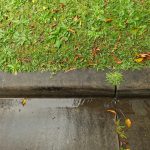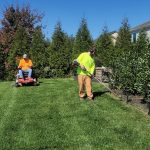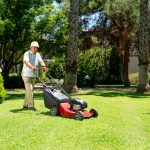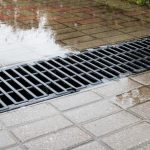As the vibrant greens of summer begin to fade, fall marks a critical transition period for lawns, especially in places like Elgin, Illinois. The cool, crisp air of autumn not only brings a change in scenery but also signals the need for a shift in how we care for our outdoor spaces. This season poses unique challenges due to fluctuating temperatures and increased leaf fall, making it the perfect time to focus on maintaining a healthy, thriving lawn.
Caring for your lawn during this transition is crucial for several reasons. A well-maintained lawn in the fall sets the stage for lush growth in the spring. For residents of Elgin, tackling these tasks now will ensure your yard is not just surviving but thriving when the warmer months return. By providing your lawn with the attention it needs during these autumn months, you’ll enjoy a vibrant, resilient yard that can handle whatever winter throws its way.
Preparing Your Lawn for Fall
Getting your lawn ready for fall requires a few strategic steps that can make a big difference. First, it’s time to deal with all those falling leaves. While they may look picturesque, leaving them scattered across your lawn can lead to blocked sunlight and moisture retention, which might become a breeding ground for mold. Raking and removing leaves regularly helps maintain healthy grass beneath.
Next up is aeration. As the soil gets compacted during summer activities, aeration becomes essential in the fall. This process involves perforating the soil with small holes to allow air, water, and nutrients to reach the grass roots. This helps the lawn breathe, promoting stronger root growth and an overall healthier yard.
Overseeding is another vital step to consider. Adding more seeds to your existing lawn can help fill in thin areas, making your grass thicker and more robust. For the best results, choose grass seed that is well-suited to the Elgin climate. This not only improves the look of your lawn but also its resilience against pests and diseases that might come with chilly weather.
Combining these steps creates a solid foundation for your lawn, preparing it to withstand the challenges of the colder months while laying the groundwork for a flourishing spring.
Fall Fertilization Tips
Fertilizing your lawn in the fall is a smart move to keep your grass healthy all year round. But not just any fertilizer will do the job. Look for ones with a high nitrogen content because they support root growth and strength, which is exactly what your grass needs this time of year. These nutrients help your lawn store energy that it will rely on once spring arrives.
Getting the process right is simple. Follow these steps:
- Choose the Right Day: Pick a day when rain is in the forecast. Moisture helps the fertilizer sink into the soil, reaching the roots.
- Apply Evenly: Use a spreader to ensure the fertilizer is evenly distributed.
- Water If Needed: If there is no rain, give your lawn a good soak to activate the nutrients.
The main difference between fertilizing in fall and spring lies in the grass’s needs. In spring, the focus is on green growth, requiring balanced nutrients. Fall fertilization targets root development, which is crucial for enduring the cold months ahead.
Watering and Mowing Practices
As cooler temperatures set in, your lawn’s thirst gradually decreases. Over-watering can lead to problems like fungal growth and waterlogged soil. Adjust your watering schedule to once a week, making sure the soil maintains consistent moisture without being soggy.
When it comes to cutting the grass, the rule of thumb is to keep it a bit longer in fall. This helps protect the roots from frost. As temperatures drop, grass growth slows, so you’ll find you don’t need to mow as often. Aim to keep your grass blades about 2.5 to 3 inches tall.
Managing lawn debris is another key task during fall. Twigs and grass clippings could foster pests and diseases if left unchecked. A quick weekly cleanup can save trouble later on. By sticking to these practices, you’re setting up your lawn for a stress-free cold season.
Addressing Common Fall Lawn Issues
Fall brings its own set of lawn challenges, but with a bit of preparation, they can be easily managed. One issue to watch for is fall pests, such as grubs that love to munch on roots. Remedies include applying a pest control treatment suited for your specific lawn and pest types. This keeps your grass from becoming patchy and weak.
Bald spots are another concern as the season progresses. Overseed those areas early in the fall to give the new grass time to establish before the cold sets in. This ensures the bare patches won’t turn into bigger problems come spring.
Yard waste can quickly pile up, leading to mold and other issues. Regularly removing leaves and organic debris not only keeps your lawn tidy but also reduces the risk of diseases. A clean lawn is a happy lawn, ready to brave the winter months.
Transform Your Fall Lawn Care Routine
Bringing all these elements together transforms how you might approach fall lawn care. Each step we’ve outlined plays a part in setting up a hearty, resilient lawn that grows better with each season.
By making these tasks part of your fall routine, your lawn will not only withstand winter but also wake up healthier when spring arrives. Investing a bit of time and effort now ensures your yard remains a source of pride and enjoyment year-round.
For a beautifully maintained lawn that stands the test of any season, trust the expertise of Bright Green Landscapes. Our dedication to providing top-notch landscaping maintenance services ensures that your Elgin yard will flourish, even in the challenging fall months. Don’t leave your lawn’s health to chance—let us handle the hard work so you can simply enjoy your vibrant outdoor space. Contact us today to discover how we can transform your lawn care routine!







